If you ever want a healthy meal or some comfort food, tea okayu (or tea porridge) is a great choice. It’s easy to make, needs simple ingredients, and you can customize it to suit how you’re feeling or what you like. It’s nutritious too! You can adjust the taste based on how you feel that day. Tea porridge has a delicious flavor and a rich aroma. This article will explore more about this special dish.
What is Tea Okayu?
Tea Okayu (or Tea porridge), also known as ‘okaisan’ in some places, uses rice and tea as its main ingredients in Japanese cuisine. It’s considered a specialty in Yamaguchi, Wakayama and Nara Prefectures. It’s a simple yet special dish. Its comforting taste is like a soulful food enjoyed by people of all ages in Japan.
Tea porridge was actually the earliest form of ‘fast food’ created to reuse leftover rice during tough times. Though it might seem basic, it’s a clever way to make ordinary ingredients taste great without any waste.
This dish is also great for managing health. It’s a warm, healing meal for the weak or sick. Even though it’s simple, it’s full of nutrients and offers a balanced diet.
You can find tea porridge in the manga ‘Oishinbo’ and in restaurants all over Japan, especially in the Kanto region. Its simplicity and preparation reflect the essence of Japanese culture. It embodies the heart of traditional Japanese food.
History
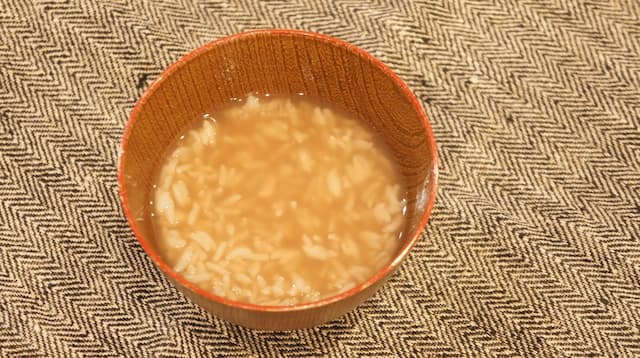
Origin of Okayu
Porridge is a dish widely enjoyed across Asia, including China, Korea, Thailand, Indonesia, as well as in Central and South America and Africa. However, its exact origins remain uncertain.
Historical evidence traces the existence of porridge in China back to at least 3000 years ago. In Japan, rice cultivation began during the Yayoi period. During this time, rice was typically ‘steamed,’ and the version cooked with water was referred to as ‘porridge.’ There were two types: a soft, moist porridge known as ‘soup porridge’ and a firmer version termed ‘solid porridge.’ The ‘soup porridge’ closely resembles today’s ‘okayu,’ while the ‘solid porridge’ resembled what is now considered regular cooked rice.
History of Tea Okayu
Chagayu, a dish known outside Yamaguchi Prefecture, is believed to have its roots in Nara. Around the early 17th century, Lord Yoshikawa from Iwakuni Domain in Yamaguchi promoted its use to save rice, spreading its popularity to places like Yanai City and Suo Oshima Town. By combining tea and boiling, it’s now considered a ‘healthy food.’
In Yamaguchi, Chagayu stands out for its method of using roasted bancha in a tea bag. It’s boiled in a special iron kettle called ‘kama,’ then rice is added after removing the tea bag. The dish boasts a smooth texture and is enjoyed warm in winter and cold in summer. Initially a staple for commoners, each family has its unique way of cooking it, turning it into a sort of ‘signature dish.’ Sweet potatoes, abundantly grown in Suo Oshima and Yanai, lend a gentle sweetness to ‘Imogayu.
Features
It’s tasty when warm in winter or chilled by soaking in water during summer. It’s easy to eat, especially when you’re not very hungry because it feels smooth in your mouth. In the mountains, folks use bancha since they make their own tea, while in the plains, hojicha is common. I’ve never heard of using green tea.
Tea shops and supermarkets sell roasted tea and bancha in tea bags specifically for tea porridge. People from outside the area often buy these in bulk to make tea porridge. But even the regular roasted tea in tea bags can make it delicious.
Differences between porridge and tea porridge
When you think of ‘porridge,’ it’s usually a soft meal made by boiling rice in lots of water. It’s moister than regular rice, giving it a smooth, soft texture. You can add seafood, meat, or veggies to make it tastier and more nutritious. It’s easy to digest, so it’s used when you’re not feeling well or as a hospital meal.
But ‘tea porridge’ is made using tea instead of water. It’s part of the traditional Japanese diet for staying healthy. The tea’s aroma and taste soak into the rice, making it really flavorful. If you want, you can skip adding salt and just enjoy the tea’s flavor.
Both ‘porridge’ and ‘tea porridge’ are widely used in Japanese food culture. They’re versatile, used from everyday meals to managing health. With different flavors and nutrients, you can choose and enjoy them based on how you feel that day.
Heath Benefits of Tea Okayu
Tea porridge, a traditional Japanese meal made with tea and rice, offers not just taste but also numerous health advantages.
Natural Nutrients
Tea porridge contains natural nutrients from tea leaves and rice. It’s not made with artificial stuff. This means it’s packed with useful things like caffeine and theanine, making it a powerhouse of goodness for your body. Tea leaves have lots of vitamin C, which helps keep skin healthy and boosts immunity, giving you that extra edge in staying well.
Easy on Digestion
This meal is gentle on your body and helps with digestion. When you’re not feeling well or don’t have a big appetite, tea porridge is great to eat. It’s light and doesn’t put too much stress on your system, making it an ideal choice when you need something comforting yet easy to digest.
Fiber for Health
Tea leaves and rice in this porridge are rich in fiber. That’s good because it helps prevent constipation and keeps your gut healthy. This natural fiber duo also helps in setting up a good environment in your intestines, supporting better digestion overall.
Antioxidant Power
Recent studies show that tea leaves in the porridge have something called catechins. These things fight against aging and help you live healthier for longer. They act like tiny superheroes in your body, protecting you from harm caused by free radicals and promoting better health.
Weight Management and Warmth
Tea porridge is good if you want to manage how much you eat or how fast you eat. It’s also nice if you want to stay warm. Plus, if you’re trying to avoid constipation while on a diet, it can help. Its delightful taste coupled with these health benefits makes it a win-win situation for those aiming for a balanced diet and warmth in colder weather.
Special Ingredient for Circulation
Tea porridge has a unique ingredient called pyrazine from roasted tea. This stuff helps your blood move better and warms up your body. It’s like giving your circulation a boost, ensuring your body stays cozy and well-nourished.
Therefore, let’ try having tea okayu often! It’s not only delicious but also good for your heath. The more we know about it, the more it’ll help us stay healthy.
Tea Okayu FAQ
- What makes Tea Okayu different from regular Okayu?
Tea Okayu is distinct because it’s prepared using tea instead of water. This addition infuses the rice with the aroma and taste of the tea, giving it a unique flavor compared to traditional Okayu.
- Is Tea Okayu suitable for all seasons?
Yes, indeed! It’s versatile and enjoyable in both warm and cold weather. During winter, it offers a comforting warmth, while in summer, it can be chilled for a refreshing meal, making it a year-round favorite.
How to make Tea Okayu?
Ingredients
| Ingredients | Amount |
| Japanese short-grain rice | 1 cup |
| Water | 4 cups |
| Roasted bancha or tea leaves | 2 tbsp |
Method
In a large pot, bring the water to a boil.
Add the roasted bancha or tea leaves into the boiling water. Allow it to boil well, infusing the water with the tea’s flavor.
Remove the tea leaves from the pot once the water has been infused.
Rinse the Japanese short-grain rice thoroughly, then add it to the pot with the tea-infused water. Cook it over high heat.
As the rice cooks, use a rice paddle (or a la lamle) to gently stir it occasionally. This helps prevent sticking and ensures even cooking.
Keep a close eye on the rice as it cooks. Once the rice has absorbed the water and swells, turn off the heat promptly. It’s essential not to overcook the rice; stopping at the right time maintains the desired consistency.
Let the Tea Okayu rest for a few minutes before serving. This comforting dish can be enjoyed warm during colder seasons or chilled for a refreshing meal in summer.
Recommended restaurants & stores
Kasuganinaijaya (春日荷茶屋)

Kasuga Kajaya, close to Kintetsu Nara Station, is a favorite at Kasuga University. People like it for its calm feel and nice views, as shared by Maron Mama. Mr. Oguzo talks about their special dish, “Manyo-gayu.” It’s Tea Okayu with different veggies each month, making it tasty every time. Mr. Shishi recommends the “Yamato Specialty Meal,” a mix with Tea Okayu, mackerel persimmon leaf sushi, and kuzumochi. They make each dish carefully, giving them lots of flavors. Kasuga Kajaya is a top spot for Tea Okayu lovers, offering a mix of tradition, changing tastes, and careful cooking.
Tou no chaya (塔の茶屋)

At ‘Tou no Chaya,’ a short walk from Kyobate Station, you’ll find a truly Japanese-style building, reflecting its authentic taste. The specialty here is tea porridge, boldly stated on the entrance curtain. They use green tea, evident from its vibrant color, creating a refreshing yet rich taste. The ‘Chagayu Bento,’ a crowd favorite, offers a luxurious set meal featuring the renowned tea porridge alongside a variety of colorful kaiseki dishes. To top it off, they serve delightful warabi mochi for dessert, making for an incredibly satisfying dining experience.
Todaiji Emado Chaya (東大寺絵馬堂茶屋)

“Todaiji Emado Chaya,” found near Todaiji Temple’s Marchido Hall, attracts visitors keen on dining while touring the temple grounds. Adorned with a distinctive red bench, it presents a charming exterior.
According to monkey man’s image, the “Yamato’s tea porridge” offers a simple meal comprising tea porridge served with sides and Narazuke pickles. They use roasted tea, blending its slight roasted green tea flavor harmoniously with the rice’s sweetness.
Additionally, Mr. derorin’s snapshot showcases the “Persimmon leaf sushi and noodle set,” highlighting Nara’s renowned cuisine. The sushi features mackerel and salmon, making this menu a popular choice to savor two of Nara’s famous dishes alongside the delightful tea porridge.
Takeaway
Tea porridge is cleverly made to fill you up using less rice. It tastes different from regular porridge and is easy to eat, especially when paired with Kinzanji miso and pickles. You can find special tea for it in supermarkets here, but it might not be as popular outside Wakayama and Nara. If you visit these places, try it out at local restaurants—it’s worth a taste!
There are also other Japanese dishes related to porridge! Find details below!
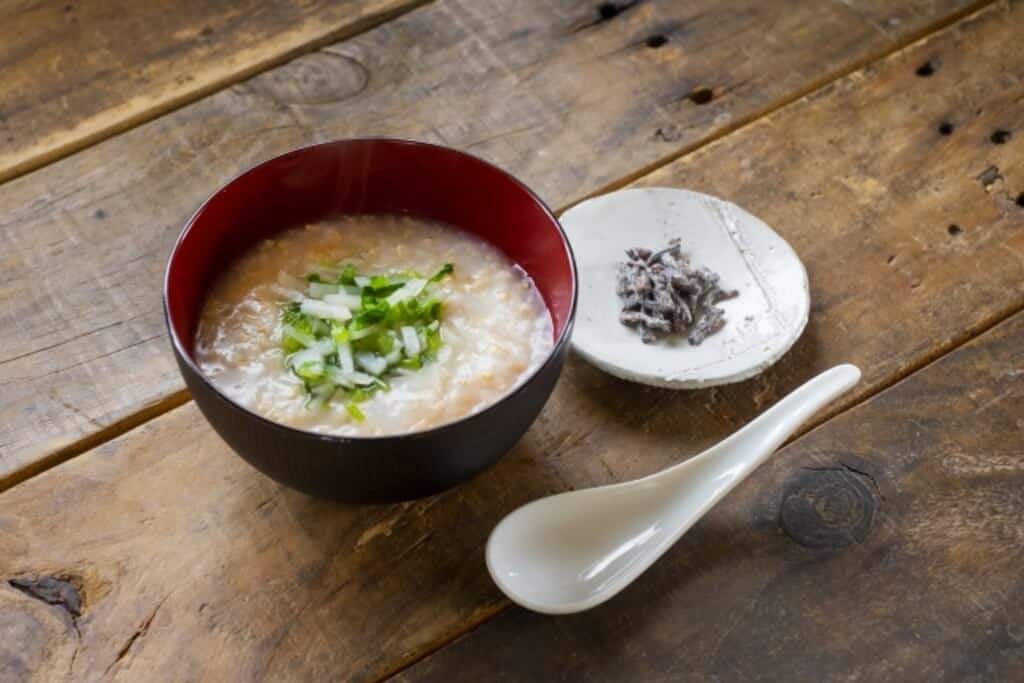
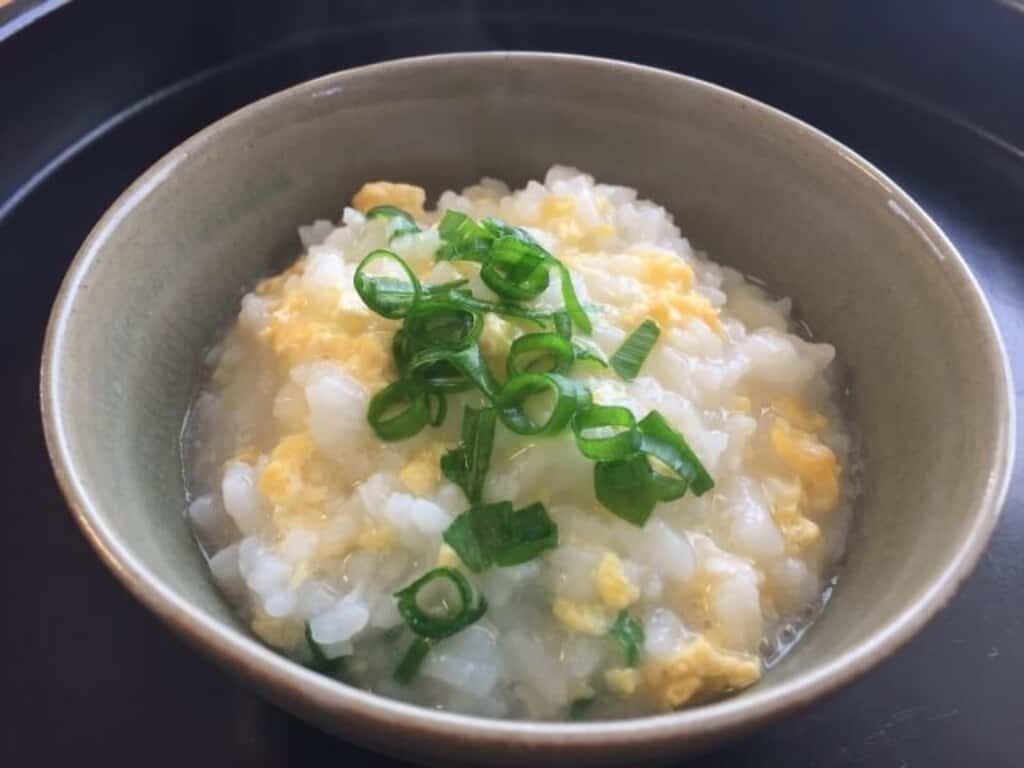

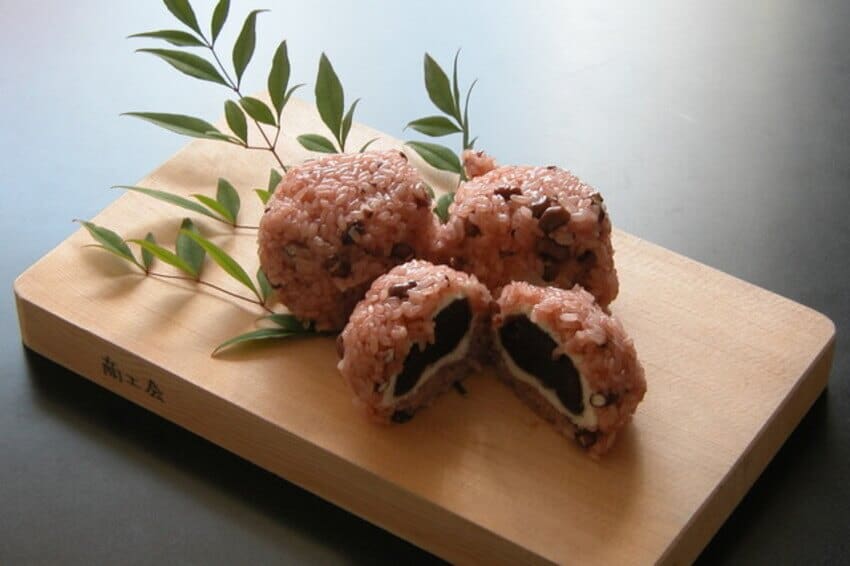






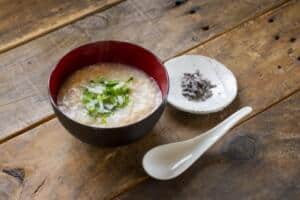
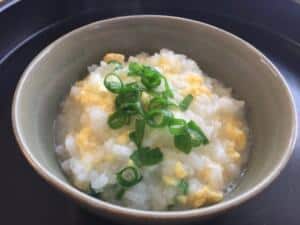
Comments